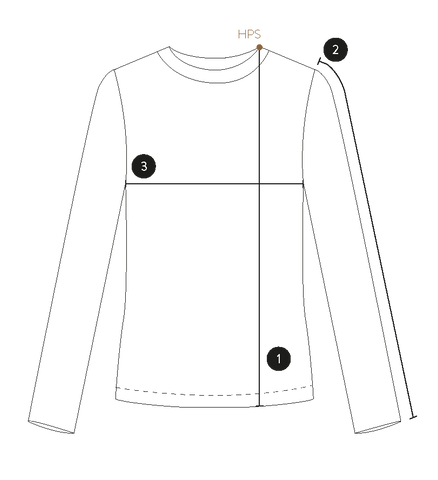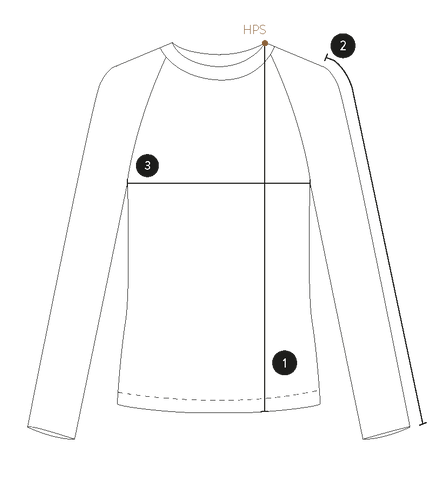Knowing how to take body measurements for clothing allows you to make better decisions when choosing a size while online shopping.
We recommend that you take body measurements wearing undergarments or light and thin layers, so that measurements are as precise as possible. Wearing bulky or thick clothing when measuring can cause variations. Measurements should be taken standing up in an upright position and preferably barefoot.
Use a flexible measuring tape so it adapts to the body's natural curves. If you can, ask someone else to assist you so it's even easier. Measurements should not be taken by tightening the tape over the body, but rather leaving a slight fingerbreadth gap underneath it so it holds up comfortably.
How to take body measurements
The HPS or high point shoulder is at the base of the neck. Locating it can serve as a useful reference point for other measurements.

➊ Arm length: Measure from the acromion (the tip of the shoulder) to the wrist bone, following the external outline of the arm, over the elbow in a relaxed position. The tape should also fold slightly, following the natural curve of the arm.
➋ Bust: Place the measuring tape around the chest under the armpits across the shoulder blades horizontally. Measure the fullest part of the bust. The tape must be parallel to the floor and hold up against the body without pressure.
➌ Waist: Measure around your natural waist—the thinnest part of your torso, forming a circumference around the abdomen and back. The tape must be parallel to the floor and held without pressure.
➍ Hip: Whilst standing straight, measure around the fullest part of the hip and bottom. Once more, the tape should be parallel to the floor and held without pressure.
➎ Center front length: The distance between the HPS (base of the neck) and the waist in a straight line, over the fullest part of the bust.
How to measure clothing
Once you have your body measurements, it might be useful to check the measurements of the garment you're considering, to approximate how it will fit and how it may vary according to the size.
If you have any questions or doubts regarding a specific style, we recommend that you take a similar garment already in your closet as reference.
At SISA, we publish relevant measurements in each product page in order to help you select your size. These measurements vary according to the type of garment—particularly whether it's a top or bottom.
Measuring a top:

➊ Body length: The length of the garment extended over a flat surface. Measure from the HPS (base of the neck) in a straight line down to the hem.
➋ Sleeve length: The length between the acromion (the tip of the shoulder) to the edge of the cuff, following the sleeve's outline.
➌ Body width: The width of the garment extended over a flat surface—measure the distance between the stitches below the armpits.
Other kinds of tops:
In the case of garments that do not have a defined scye (armhole), such as raglan sleeves, Japanese-style sleeves or bat sleeves– or garments with a dropped shoulder design, the sleeve length is also measured from the acromion (the tip of the shoulder) to the edge of the cuff.

➊ Body length
➋ Sleeve length
➌ Body width
Measuring pants:

➊ Inseam: The length between the stitches at the crotch and the hem. Measure in a straight line following the inside seam of the leg.
➋ Garment length: The length of the pant extended over a flat surface. Measure from the waist (including the waistband) down to the hem, over the outer seam of the leg.
➌ Front rise: The length between the waist (including the waistband) to the crotch. The front rise measurement helps you determine whether a pant style is high-rise, mid-rise or low-rise. It is useful to compare the front rise to that of a pair of pants already in your closet.
➍ Waist: The circumference of the garment measured around the top edge of the waistband.
➎ Hip: The circumference of the garment measured around the hip—where the fullest part of the bottom would be. Measure the width of the front and back of the garment.
How to determine your size
To select your size at SISA, we recommend you take your body measurements first. Use our standard sizing chart to determine the size that is closest to your body measurements. Check our sizing chart here.
Then, check the product description as it will contain relevant measurements by sizes, depending on the style and fit. For instance, we generally publish the body length and sleeve length of sweaters and blouses, as well as the inseam of jeans. This may help you understand how much the garment measurements will vary according to the size.
On each product page you will also find the models' height and the size they're wearing in the photos. This can also serve as a reference point –albeit on their specific body type– to complement sizing information.
If you have any questions regarding the sizing of a SISA piece or require a specific measurement that does not appear on the product page, you may contact us at ventas@shopsisa.com and we will be glad to help as much as we can.
